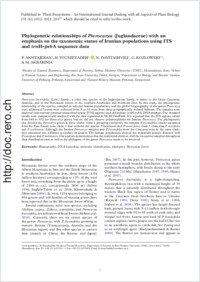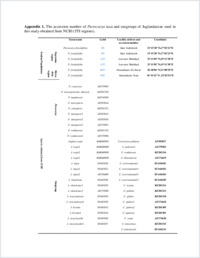Phylogenetic relationships of Pterocarya (Juglandaceae) with an emphasis on the taxonomic status of Iranian populations using ITS and trnH-psbA sequence data
- Mostajeran, F. Faculty of Natural Resources, Department of Forestry, Tarbiat Modares University, Mazandaran, Iran
- Yousefzadeh, H. Faculty of Natural Resources, Department of Forestry, Tarbiat Modares University, Mazandaran, Iran
- Davitashvili, N. School of Natural Sciences and Engineering, Ilia State University, Tbilisi, Georgia
- Kozlowski, Gregor Department of Biology and Botanic Garden, University of Fribourg, Switzerland - Natural History Museum, Fribourg, Switzerland
- Akbarinia, M. Faculty of Natural Resources, Department of Forestry, Tarbiat Modares University, Mazandaran, Iran
-
02.11.2017
Published in:
- Plant Biosystems - An International Journal Dealing with all Aspects of Plant Biology. - 2017, vol. 151, no. 6, p. 1012–1021
English
Pterocarya fraxinifolia (Lam.) Spach., a relict tree species of the Juglandaceae family, is native to the Great Caucasus, Anatolia, and to the Hyrcanian forests of the southern Azerbaijan and Northern Iran. In this study, the phylogenetic relationship of the species, sampled in selected Iranian populations, and the global biogeography of the genus Pterocarya were addressed. Leaves were collected from 8 to 10 trees from three geographically isolated habitats. The samples were analyzed with nuclear (internal transcribed spacer [ITS] regions) and chloroplast (trnH-psbA) DNA markers. The obtained results were compared and analyzed with the data registered in NCBI GenBank. It is reported that the ITS regions varied from 644 to 652 for Pterocarya genus, but we did not observe polymorphisms for Iranian Pterocarya. The phylogenetic tree divided the Pterocarya genus in three clades: clade 1 grouping exclusively the samples P. fraxinifolia, clearly separated from the East Asiatic taxa; clade 2 that includes the species P. hupehensis and P. macroptera; clade 3 clustering P. stenoptera and P. tonkinensis. Although the Iranian Pterocarya samples and P. fraxinifolia from the Caucasus were in the same clade, they presented two different secondary structures. The Iranian populations showed the maximum genetic distance with P. stenoptera and P. tonkinensis. Our analysis demonstrates that the traditional division of all the six species sampled throughout their distribution area as well as the phylogeny of the genus Pterocarya needs to be reviewed.
- Faculty
- Faculté des sciences et de médecine
- Department
- Département de Biologie
- Language
-
- English
- Classification
- Biological sciences
- License
- License undefined
- Identifiers
-
- RERO DOC 306195
- DOI 10.1080/11263504.2016.1219416
- Persistent URL
- https://folia.unifr.ch/unifr/documents/306332
Other files
Statistics
Document views: 72
File downloads:
- koz_prp.pdf: 189
- koz_prp_sm.pdf: 97

